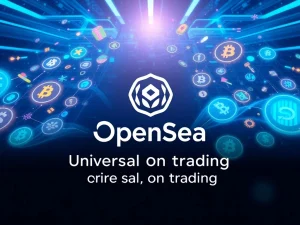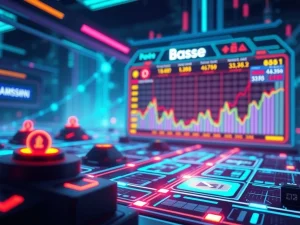Dramatic Shift: Aavegotchi NFTs Make Bold Move From Polygon to Base

In a stunning development for the Web3 gaming world, Aavegotchi, the popular NFT protocol, has voted to sunset its operations on Polygon and fully embrace Base, an Ethereum layer-2 scaling solution. This strategic pivot, overwhelmingly approved by the Aavegotchi community, signals a significant shift in the blockchain gaming landscape. What drove this dramatic decision, and what does it mean for the future of NFTs and blockchain networks?
Why Aavegotchi is Leaving Polygon for Base: A Strategic NFT Shift
The onchain vote, concluded on April 8th, revealed a resounding 93.5% of Aavegotchi community members in favor of the proposal to “Make Aavegotchi Based Again.” This move involves deprecating existing smart contracts on Polygon and redeploying them entirely on Base. Aavegotchi founder, known as Dan, articulated the rationale behind this bold step in a February X post, citing a combination of factors:
- Polygon’s Flat TVL Growth: Despite its initial promise, Polygon has experienced relatively stagnant growth in Total Value Locked (TVL), a crucial metric indicating user engagement and platform health.
- Base’s Retail Strength: Base, launched by cryptocurrency exchange giant Coinbase, has demonstrated significant traction, particularly among retail users, a key demographic for Web3 gaming and NFTs.
- Strong Relationship with Base Team: Aavegotchi developers have fostered a close working relationship with the Base team, suggesting collaborative opportunities and support for future growth.
- Optimizing for the Current Cycle: In the face of a challenging cryptocurrency market, Aavegotchi aims to position itself on a chain that offers the best prospects for growth and user adoption in the current market conditions.
This decision underscores the dynamic nature of the blockchain space, where projects must adapt and evolve to thrive. For Aavegotchi, this means prioritizing a platform that aligns with their strategic goals in the evolving NFT and gaming landscape.
Polygon’s TVL Challenges: A Deeper Dive
Aavegotchi’s decision shines a spotlight on the ongoing challenges faced by Polygon in maintaining its position as a leading Ethereum layer-2 scaling solution. While Polygon once boasted a TVL nearing $10 billion in 2021, data from DefiLlama reveals a significant decline to approximately $725 million as of April 8th. In stark contrast, both Base and Arbitrum, other prominent Ethereum layer-2 chains, currently hold over $2 billion in TVL each.
What does TVL signify?
TVL, or Total Value Locked, is a critical metric in Decentralized Finance (DeFi). It represents the total value of assets deposited within a protocol. A high TVL generally indicates:
- Strong User Trust and Adoption: Users are willing to lock their assets in the protocol, signifying confidence.
- Healthy Liquidity: A larger pool of locked assets translates to greater liquidity, facilitating smoother transactions and platform functionality.
- Platform Growth and Activity: TVL is often seen as a barometer of a DeFi platform’s overall health and growth trajectory.
According to Aavegotchi founder Dan, a key concern regarding Polygon is the perceived lack of recent updates and features specifically beneficial to gaming protocols. He stated, “Polygon has not shipped any significant updates or features to PoS to enable better ecosystem coherence or discovery for gaming.” This perceived stagnation in gaming-focused development may have contributed to Aavegotchi’s search for a more dynamic and supportive environment.
Polygon TVL Decline: A Visual Snapshot
| Blockchain Network | TVL (Approx. as of April 8, 2024) |
|---|---|
| Polygon | $725 Million |
| Base | $2 Billion+ |
| Arbitrum | $2 Billion+ |
Why Base? The Allure of a Retail-Focused Ethereum Layer-2
Dan highlighted the strengths of both Base and Arbitrum, describing them as “performant and ‘lindy’ – able to stand the test of time.” However, he emphasized Base‘s particular appeal due to its “stronger retail onboarding.” Several factors contribute to Base’s growing popularity and attractiveness, especially for projects like Aavegotchi targeting a broad user base:
- Coinbase Backing: As a layer-2 solution incubated by Coinbase, the largest cryptocurrency exchange in the US, Base benefits from Coinbase’s vast user base and established brand recognition.
- Retail User Focus: Base is designed to be user-friendly and accessible, making it particularly appealing to retail investors and users entering the crypto space. This aligns perfectly with the accessibility and community-driven nature of many NFT projects.
- Optimistic Rollup Technology: Base utilizes optimistic rollup technology, which offers scalability and lower transaction fees compared to the Ethereum mainnet, while still inheriting Ethereum’s security.
- Ecosystem Growth: Base has witnessed rapid ecosystem growth since its launch in 2023, attracting a diverse range of projects and applications, fostering a vibrant and active community.
What is Aavegotchi? A Quick NFT Primer
For those unfamiliar, Aavegotchi is a unique NFT protocol focused on Web3 gaming. These aren’t just any NFTs; Aavegotchis are described as “digital collectibles” with a playful and customizable nature. Key features of Aavegotchi NFTs include:
- Customization: Aavegotchis can be personalized with various wearables and accessories, allowing users to express their individual style and enhance their digital pets.
- Trading and Collectibles: Aavegotchi NFTs can be bought, sold, and traded on marketplaces, creating a dynamic and engaging ecosystem for collectors and players.
- Gaming Focus: Aavegotchi is deeply integrated with Web3 gaming, offering play-to-earn opportunities and engaging gameplay experiences centered around these unique NFT avatars.
- Collaboration with Aave: Aavegotchi was created through a collaboration between Pixelcraft Studios and Aave, a prominent decentralized lending protocol, adding further credibility and innovation to the project.
Looking Ahead: The Impact of Aavegotchi’s Base Move
Aavegotchi’s decision to “go all-in” on Base is a noteworthy event in the NFT and blockchain gaming sectors. It underscores the importance of network selection for projects seeking sustainable growth and user engagement. While Polygon continues to be a significant player, this move highlights the rising prominence of Base as a compelling alternative, particularly for retail-focused applications and gaming ventures. As the crypto landscape evolves, projects like Aavegotchi are demonstrating the agility and strategic thinking required to navigate the dynamic world of blockchain technology and NFTs.
This strategic shift could be a harbinger of further migrations and network realignments as projects seek the optimal platforms to thrive in the ever-changing cryptocurrency ecosystem. The focus now shifts to how Aavegotchi’s move to Base will unfold and what impact it will have on both communities and the broader Ethereum layer-2 landscape.









